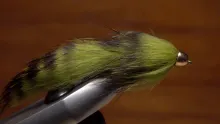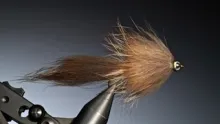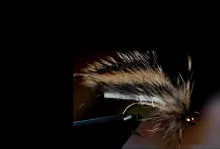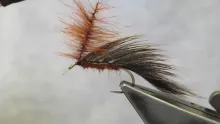This article features a handful of zonker patterns, which we cover in connection with our thorough theme on tying zonker flies and cutting or buying zonker strips.
A list of patterns using zonker strips, featured in connection with our zonker theme.
Squirrel Zonker
This was one of the first "small zonkers" that I tied and used, and a pattern that dates back a couple of decades, but was updated just recently. It was created based on a cured squirrel skin that I got my hands on, and after cutting some zonker strips from this dense and short haired skin, the fly was a simple and easily tied creation consisting of a tinsel body, a zonker wing and a hair hackle. The fly is compact and lightweight and can be tied on smaller hooks and still yield a harmonic fly.
See the full article on the Squirrel Zonker here.
Fair Fly
Like the Squirrel Zonker, this was inspired by the wing material, which in this case was a nutria skin. Nutria is a type of fur that's pretty close to mink, and you can easily "substitute" the nutria with mink. I write substitute in brackets because the substitute is usually done the other way round, using the fairly inexpensive nutria in stead of the much more expensive mink when making fur coats.
You can see the pattern here, but let me recap the origin of the fly: During a fly tying demonstration at the Dutch fly fair many moons ago, a spectator asked me how to tie a zonker, and when I dug into the bag, I pulled out the nutria skin, which I had bought just weeks before. I cut a strip and tied the first Fair Fly. I think I gave the first one to the show guest, but have since then tied and fished the fly many times.
I also tied it at the International Fly Tyer's symposium in New Jersey one year. Fellow angler Bob Perry had seen me tie it at the show, and when we were fishing the Connetquat on Long Island after the show he said: "Tie on that large fly, and cast it as close to that bank as you can. Let it sink a bit, and then strip it back."
I had been fishing small dries and nymphs in the gin clear stream all day, but tied on the large fly anyway. I think it was on the second cast close to the undercut bank that I hooked my monster of the day... and broke it off in seconds! Big fish sometimes like big flies!
The Fair Fly is an almost perfect sculpin imitation, and is easy to tie. One disadvantage is its size. Once wet the fly is quite heavy and can be a chore to cast on a lighter rod. The Twospotted Fair Fly is another fly in the Zonker/Fair Fly family.
See the full article on the Fair Fly here.
See the full article on the Twospotted Fairfly here.
FMJNM
This fly combines my favorite fly types: the muddler and the zonker. The acronym stands for Full Metal Jacket Nutria Muddler. It might as well have been called CHNZM: Cone Headed Nutria Zonker Muddler. If the Fair Fly is a beast to cast. This fly is a monster! It's pretty difficult to get airborne on a rod lighter than a 7 weight, and using an 8 or 9 weight makes casting it somewhat easier.
Thanks to the cone it's a deep diver, and fishing it at night in a current is my favorite use of the fly.
We're again talking a sculpin, and even more so, since it fishes deep.
But basically I like this fly because I think it looks good.
If you look at the article The Zuddler, you will find a ton of similar flies from the vises of Joe Emery and John Rode.
See the full article on the Full Metal Jacket Nutria Muddler here.
Martin's Mundane Zonker Worm
My Mundane Zonker Worm was one of those experiments that worked out really well. Clam worms or ragworms are very common - at least judging from the number of flies that imitate them. In real life they only appear as trout food for a few days a year, and having fished for 30 years I have still only seen the "clam worm hatch" AKA "swarming" a couple of times, and never really missed a clam worm or ragworm fly in my box.
My other problem with these flies is that they are usually way too complex for my taste. They are difficult to tie, using two hooks, string, beads, glue and all kinds of voodoo, and many seem more like desktop flies than fishing flies. Nice to look at in the vise, but not really practical to fish with, and downright impossible to tie!
The Mundane Zonker Worm is über simple: conehead, zonker strip and a hackle. It looks as much as a worm as any worm imitation I have seen, but will definitely also go for a small black fish if the trout prefer that.
The essence is that it caught fish on its maiden voyage and has done so a few times since. It works.
See the full article on the Martin's Mundane Zonker Worm here.
The Mango
The Mango is a bright and colorful zonker tied for winter and cold water seatrout. It uses the barred rabbit zonker strips, which are mentioned in the recent zonker strip article.
See the full article on the Mango.
The Bloody Zonker
This is a "zonked" version of the classical Bloody Butcher, which was originally a feather winged fly. The colors of the original - silver, red and black - becomes most fly types, and the feather wing can easily be transformed to a zonker ditto, resulting in a large streamer, well suited for larger predatory fish such as sea trout.
On the adjacent picture you can clearly see how the fly is finished with a hackle that easily disguises the bump of the zonker strip skin.
Many classical patterns - streamers, feather wings and hair winged flies - can be converted to zonkers by keeping the basic elements and colors and replacing the hook with a long shank hook and the wing with a zonker strip.
See the full article on the Bloody Zonker.
- Log in to post comments













